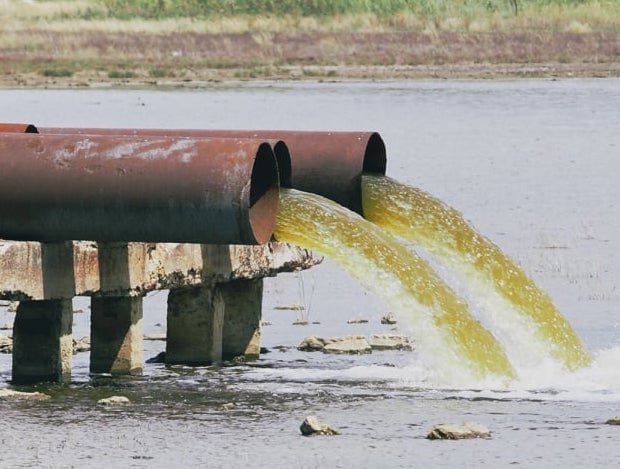How the EPA Lets Dirty Industries Pollute Our Water
Published May 8, 2023

The EPA is ignoring its legal duty to protect our waterways from dirty industries — so we’re taking it to court.
America’s waterways are some of our greatest natural treasures and a vital resource for communities across the country. People swim and boat in them, depend on them for food and their livelihoods, and draw on them for drinking water.
But the Environmental Protection Agency (EPA) has found that about half of the waterways it assessed fail our national water quality standards. Some of the biggest culprits: dirty industries that dump billions of pounds of toxic pollution into our waterways each year.
The EPA has a legal duty to protect our waters. Yet, this year the agency has failed once again to update decades-old regulations that should limit pollution from dirty industries.
That’s why Food & Water Watch has joined a dozen allies, represented by the Environmental Integrity Project, in a lawsuit against the EPA. The agency is ignoring its duty to hold polluters accountable and ensure our waterways stay clean and safe for everyone.
The EPA Should Be Tightening Limits on Industrial Water Pollution
According to the federal Clean Water Act, the EPA must set limits on how much pollution industries can dump in waterways. The goal of the Act is to eliminate pollution discharges into U.S. waters — and that can only happen if we continually strengthen regulation as technology improves. To that end, the law mandates that EPA assess and, if needed, tighten limits at least once every five years.
But EPA has once again refused to change the limits — some of which are decades old — for several dirty industries.
Guidelines for 40 of the 59 industries that the agency regulates were updated 30 or more years ago. Several of these industries, including oil refining, plastics manufacturing, and fertilizers, have limits that are nearly 40 years old.
These outdated limits are not cutting it, and as a result, our waterways are suffering.
These Dirty Industries Dump Toxic Pollution Into Our Water
Industrial water pollution is a major problem for our country’s waterways. It makes rivers and lakes unswimmable and leads to everything from deadly algae blooms to mutations in freshwater wildlife. It also adds huge costs to water treatment and threatens human health.
The biggest culprits include oil refineries, chemical and plastics manufacturers, and fertilizer plants. Here are just some of their impacts:
- U.S. oil refineries discharge nearly half a billion gallons of wastewater into waterways every day. That includes heavy metals like arsenic and mercury, oils and greases, and industrial salts. In 2021 alone, 81 refineries discharged 60,000 pounds of selenium, which causes mutations in fish. Those refineries also discharged nearly 16 million pounds of nitrogen, which creates algae blooms that suck oxygen from the water and kill fish.
- Organic chemical and plastic plants manufacture plastics, synthetic fibers like polyester, and more. These plants release millions of pounds of pollutants each year, including nitrogen, the carcinogen benzene, and lead. Plastics plants in particular discharge, without any federal limits, hormone-disrupting phthalates, PFAS forever chemicals, and microplastics. The EPA also doesn’t limit nurdles, tiny plastic pellets that often spill from plastics plants.
- The EPA estimates that 59 chemical fertilizer plants dumped nearly 90 million pounds of pollution into waterways in 2019. These plants make mostly nitrogen-based fertilizers and dump millions of pounds of nitrogen, cyanide, chromium, nickel, lead, and more into our waterways.
- Inorganic chemical plants are some of the biggest industrial dischargers of toxic pollution in the U.S. These plants make products like PVC and vinyl chloride, which recently made headlines after spilling in the train derailment at East Palestine, Ohio. The EPA estimates that 229 of these chemical plants dumped 2 billion pounds of pollution into our waterways in 2019 alone.
Updated limits could dramatically reduce these pollutants in industrial discharges. But the EPA is allowing polluters to rely on technology older than the internet.
As a result, heavy metals and toxic chemicals continue to flow into our waters every day. The EPA’s decades-old standards allow this pollution to wreak havoc on the environment and endanger our health.
The EPA Must Rein in Industrial Polluters
Low-income communities and communities of color disproportionately suffer from the harms of industrial pollution. These communities live in the shadow of polluting factories, and some bear the weight of multiple dirty industries in their backyards.
Moreover, they’re more likely to struggle to pay the costs of the additional treatment needed to ensure polluted public water is safe to drink. They’re also more likely to rely on fishing for food.
The EPA has the power and, in fact, the mandate to reduce these harms. But the agency has skirted its duty and allowed corporations to continue to pollute under outdated standards.
Rather than hold these corporations to account, the EPA has forced our communities and wildlife to bear the burden of toxic pollution. At the same time, industries like oil and gas have raked in record profits.
Families shouldn’t face higher water bills because their water system needs to clean up what industry dumped. They should be able to swim in local rivers and lakes and drink their tap water without fearing for their health.
That’s why we’re joining with allies in suing the EPA. The agency must stop ignoring its legal duty to limit pollution and do its part to keep us all safe.
We can take on important work like this because of supporters like you.
Enjoyed this article?
Sign up for updates.
TO TOP


